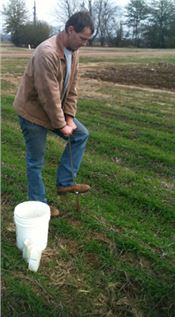Autumn Means It’s Time For Soil Sampling
FAYETTEVILLE, ARK.
Before farmers and ranchers plant annual forages for the winter, it’s a good idea to spend part of autumn checking their soil’s fertility. Their situations may call for incorporating lime and fertilizer, so soil sampling should be done to find out.
“The growth of many perennial forage crops is relatively slow or non-existent during the fall and winter, so fertility deficiencies are less crucial,” said Dirk Philipp, associate professor of forages at the University of Arkansas System Division of Agriculture. “But correcting pH will take somewhere between four and six months or even longer, so fall is a good time to tackle it.”
Philipp explained that producers should have a good idea about the growth of their forage once the grazing season is over. Underperforming pastures and changes in species composition can point to decreasing soil fertility.
Philipp recommends that farmers send in samples of their soil for an analysis on a regular basis. Arkansas is one of several states that offer the service for free at the Division of Agriculture Soil Testing and Research Laboratory in Marianna. For information about how to submit soil samples, contact soiltest@uark.edu or call 870-295-2851.
Before taking samples, farmers should divide their property into subunits based on landscape position, drainage patterns and haying or grazing history. Then, Philipp said, they should take 15 to 20 samples, each from 6 inches deep, mix all the samples into a bucket and fill a soil box provided by a county extension office.
Philipp advises farmers to take their samples in a zig-zag pattern to produce a representative sample from within that subunit. He also cautioned against taking short cuts on the number of samples per pasture. “The more you take, the more accurate and representative the results will be,” he said.
After collecting all the samples, farmers can take them to their county extension office. Personnel at the offices will explain how to label the boxes for shipment to the testing lab in Marianna.
When the lab returns the results, farmers should check with their local extension agents to review how to correct soil fertility, if necessary. The lab reports will include phosphorous, potassium and mineral analysis. They will also indicate the pH level and how much lime should be applied. Target application rates for nitrogen will also be included based upon what crop was indicated by the farmer.
“You don’t want to apply nitrogen during the winter months if the dormant pasture can’t use it, obviously,” Philipp said. “But if you plant winter annual crops into tilled seedbeds, you should consider incorporating the lime and fertilizer to increase the efficacy of your application.”
Farmers should apply lime in the fall to correct the pH. If nitrogen and other minerals are needed for winter annual crops, they those should be applied in the recommended amounts, Philipp said. ∆

Gathering soil samples requires
a few tools: a soil sampler, a bucket for
mixing the soil and a soil box for submissions.